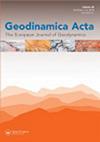土耳其中东部锡瓦斯盆地南缘蛇绿岩地球化学特征及其对内牛头海的指示意义
IF 1.5
Q1 Earth and Planetary Sciences
引用次数: 13
摘要
摘要:在土耳其中东部东陶里德地台顶部的Sivas和Malatya之间,出现了大量被肢解的蛇绿岩体。其中一个位于Tecer山地区Sivas盆地南缘,由混杂岩和Tauride平台顶部海洋岩石圈部分的下部组成。地幔构造岩的特征是可变的蛇纹石化方辉橄榄岩和纯橄榄岩,并被许多孤立的岩脉侵入。辉长岩堆积体由橄榄石辉长岩、辉长岩和辉长岩组成。镁铁质堆积岩的主元素和微量元素地球化学表明,原始岩浆的成分与现代岛弧拉斑玄武岩序列中观察到的成分相似。孤立岩脉的成分完全是玄武岩,在地球化学上显示出两个不同的亚组:第一组以高TiO2(.87–1.47 wt.%)和其他不相容元素为代表,而第二组以低TiO2(.36–.66 wt.%。I组隔离的辉绿岩岩脉具有平坦至轻度LREE贫化剖面(La/YbN=.32–.79),而第II组隔离辉绿岩岩脉总体上更为贫化,并具有LREE贫化特征(La/YbN=.19–.49)。这表明隔离岩脉来源于岛弧拉斑玄武岩岩浆(Nb/Y=.02–.05),该岩浆具有不同程度的部分熔融(第II组>第I组)和相对较高的洋内俯冲带氧逸度。研究区的蛇绿岩很可能与东南部的Divriği蛇绿岩相比较。所有证据表明,Tecer山地区的孤立岩脉与切割Divriği蛇绿岩的碱性孤立岩脉不同。由于Divriği地区的晚期岩脉(~76Ma)为碱性岩脉,本研究中的拉斑玄武岩孤立岩脉应早于内陶里德洋晚白垩世SSZ扩展(~90Ma)期间的碱性岩脉。本文章由计算机程序翻译,如有差异,请以英文原文为准。
Geochemical characteristics of ophiolitic rocks from the southern margin of the Sivas basin and their implications for the Inner Tauride Ocean, Central-Eastern Turkey
Abstract Number of dismembered ophiolite bodies crop out between Sivas and Malatya on the top of the Eastern Tauride platform in the central-eastern Turkey. One of which at the southern margin of the Sivas basin in the Tecer Mountain area comprises melange and the lower part of an oceanic lithospheric section on top of the Tauride platform. The mantle tectonites are characterized by variably serpentinized harzburgites and dunites, and are intruded by numerous isolated dykes. The gabbroic cumulates consist of olivine gabbro, gabbro and gabbronorite. The major and trace element geochemistry of the mafic cumulate rocks suggests that the primary magma was compositionally similar to those observed in modern island-arc tholeiitic sequences. The isolated dykes are exclusively basaltic in composition and display geochemically two distinct subgroups: Group I is represented by high TiO2 (.87–1.47 wt.%) and other incompatible elements, whereas Group II is characterized by low TiO2 (.36–.66 wt.%) and other incompatible elements. The Group I isolated diabase dykes have flat to slightly LREE-depleted profiles (La/YbN = .32–.79), whereas the Group II isolated diabase dykes are more depleted in general and have a LREE-depleted character (La/YbN = .19–.49). This suggests that the isolated dykes were derived from an island arc tholeiitic magma (Nb/Y = .02–.05) with different degrees of partial melting (Group II > Group I) and relatively high oxygen fugacity in intra-oceanic subduction zone. The ophiolitic rocks in the study area may well be compared with the Divriği ophiolite to the southeast. All the evidence suggests that the isolated dykes in the Tecer Mountain area differ from the alkaline isolated dykes cutting the Divriği ophiolite. Since the late stage dykes (~76 Ma) in the Divriği area are alkaline, the tholeiitic isolated dykes in the present study should have been emplaced prior to the alkaline dykes during Late Cretaceous SSZ-spreading (~90 Ma) within the Inner Tauride Ocean.
求助全文
通过发布文献求助,成功后即可免费获取论文全文。
去求助
来源期刊

Geodinamica Acta
地学-地球科学综合
CiteScore
4.50
自引率
0.00%
发文量
0
审稿时长
25 weeks
期刊介绍:
Geodinamica Acta provides an international and interdisciplinary forum for the publication of results of recent research dealing with both internal and external geodynamics. Its aims to promote discussion between the various disciplines that work on the dynamics of the lithosphere and hydrosphere. There are no constraints over themes, provided the main thrust of the paper relates to Earth''s internal and external geodynamics. The Journal encourages the submission of papers in all fields of earth sciences, such as biostratigraphy, geochemistry, geochronology and thermochronology, geohazards and their societal impacts, geomorphology, geophysics, glaciology, igneous and metamorphic petrology, magmatism, marine geology, metamorphism, mineral-deposits and energy resources, mineralogy, orogeny, palaeoclimatology, palaeoecology, paleoceanograpgy, palaeontology, petroleum geology, sedimentology, seismology and earthquakes, stratigraphy, structural geology, surface processes, tectonics (neoteoctonic, plate tectonics, seismo-tectonics, Active tectonics) and volcanism.
Geodinamica Acta publishes high quality, peer-reviewed original and timely scientific papers, comprehensive review articles on hot topics of current interest, rapid communications relating to a significant advance in the earth sciences with broad interest, and discussions of papers that have already appeared in recent issues of the journal. Book reviews are also included. Submitted papers must have international appeal and regional implications; they should present work that would be of interest to many different specialists. Geographic coverage is global and work on any part of the world is considered. The Journal also publishes thematic sets of papers on topical aspects of earth sciences or special issues of selected papers from conferences.
 求助内容:
求助内容: 应助结果提醒方式:
应助结果提醒方式:


